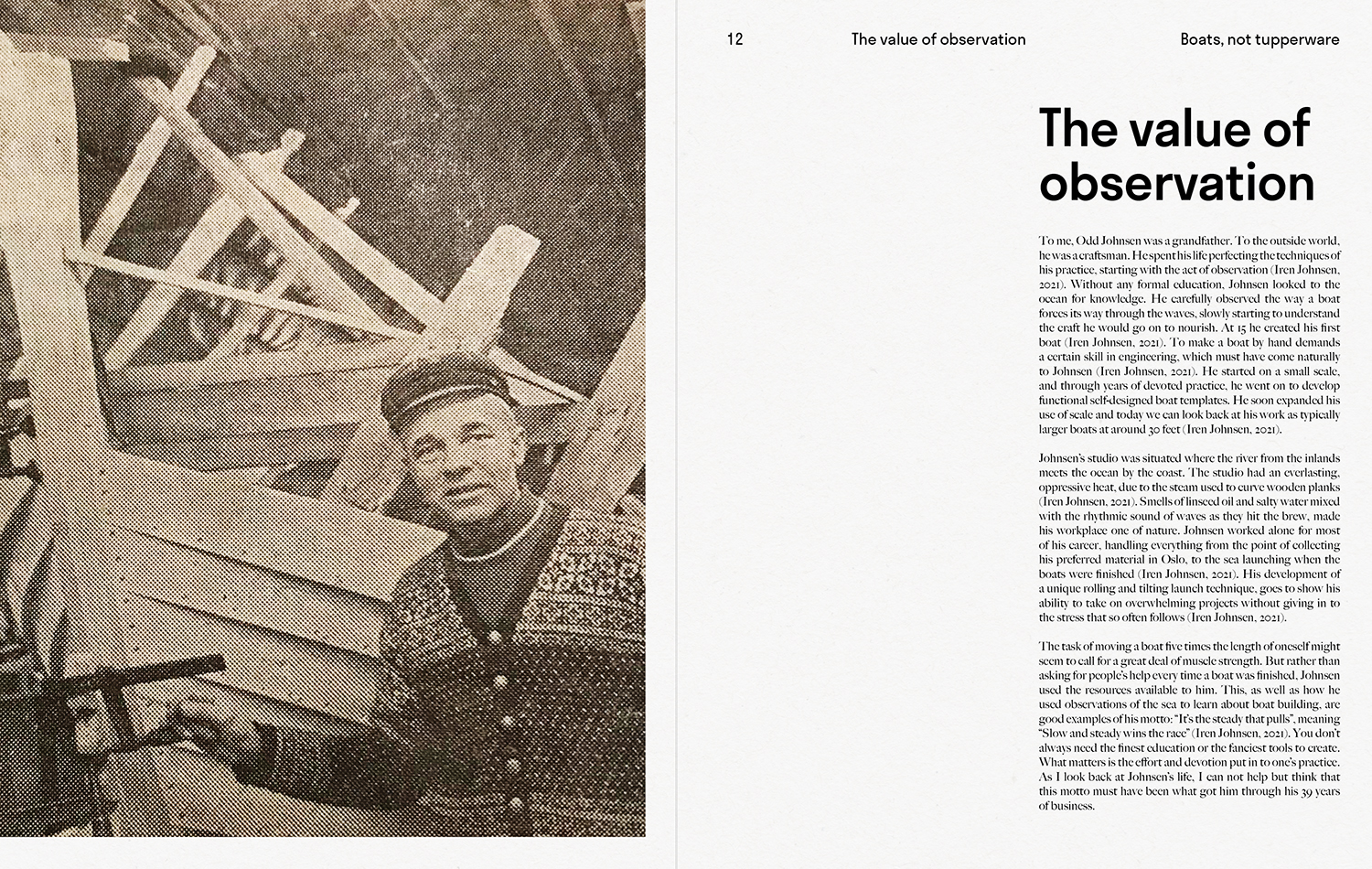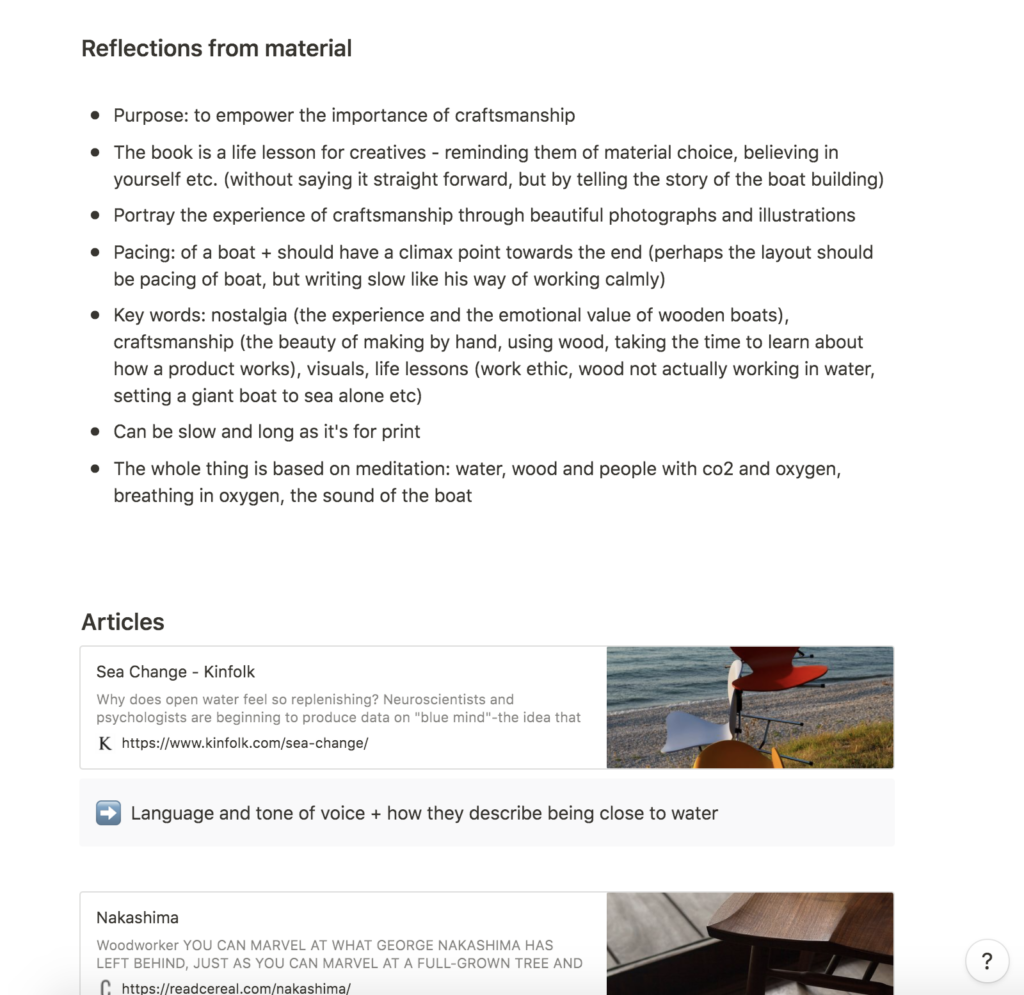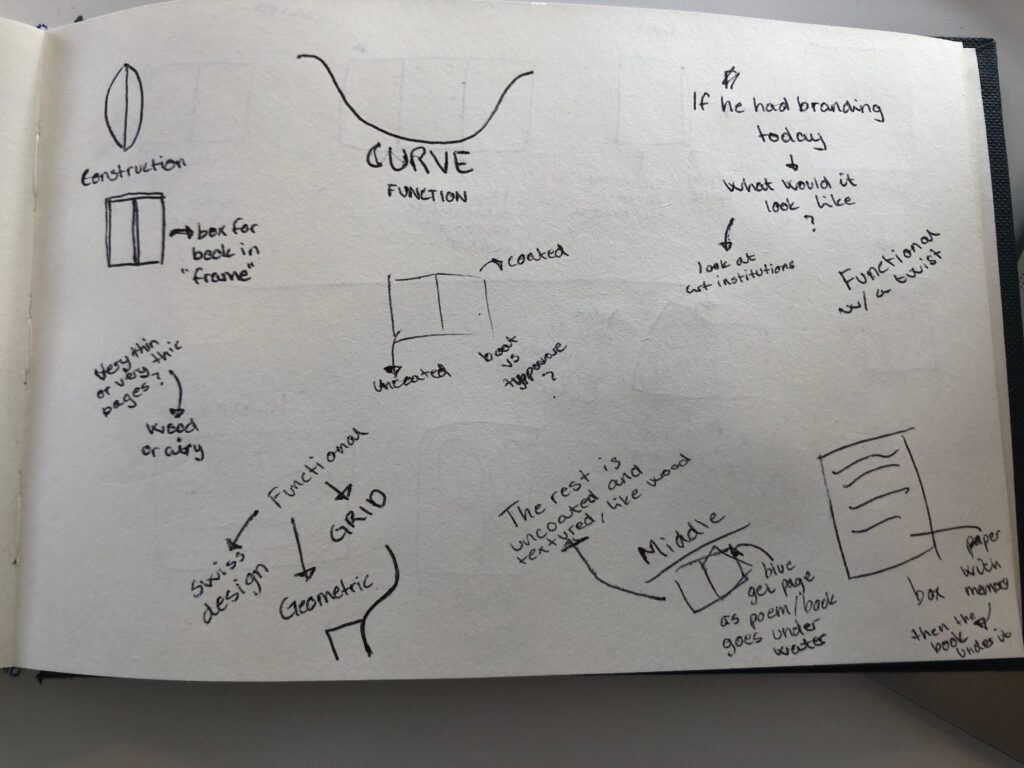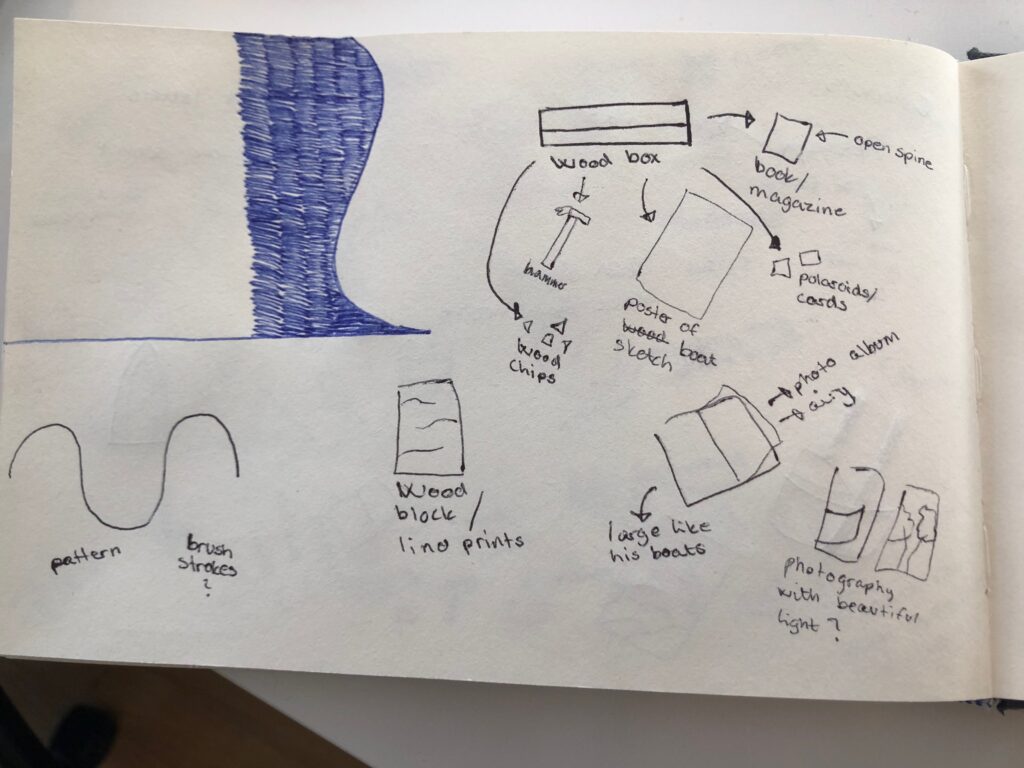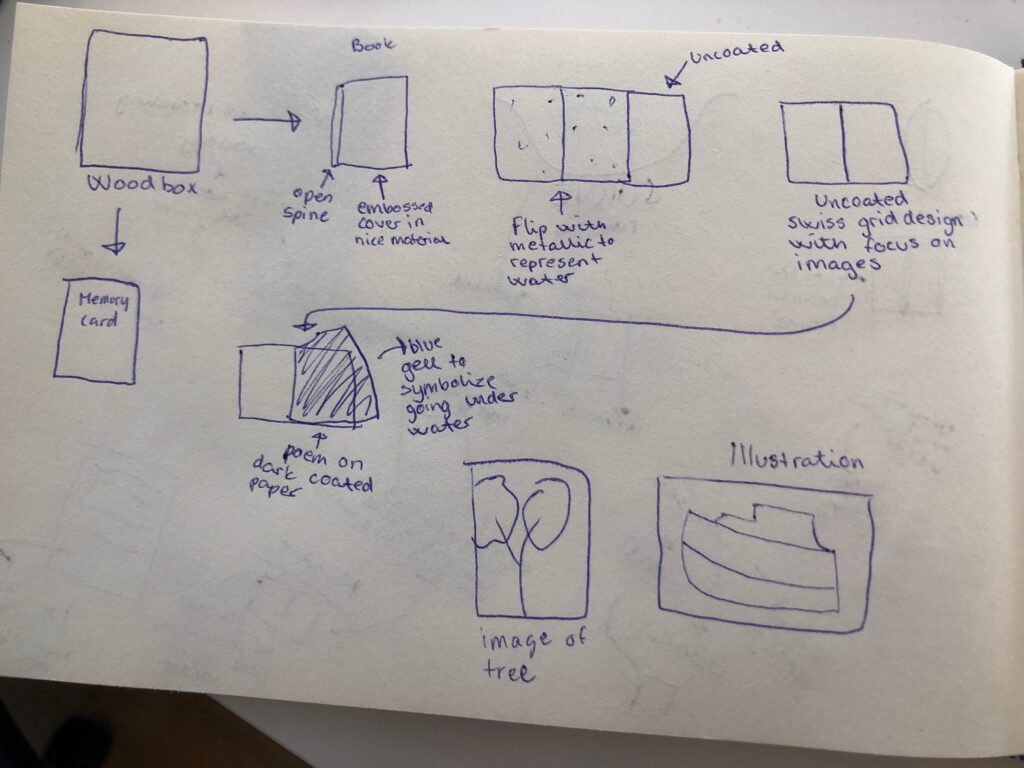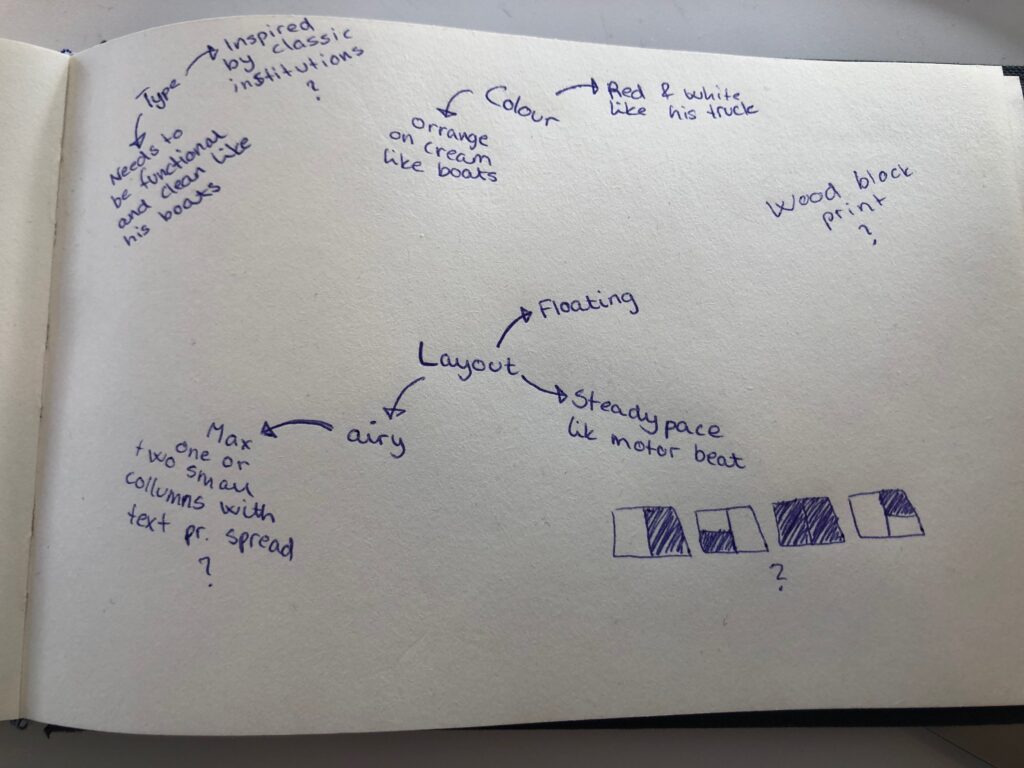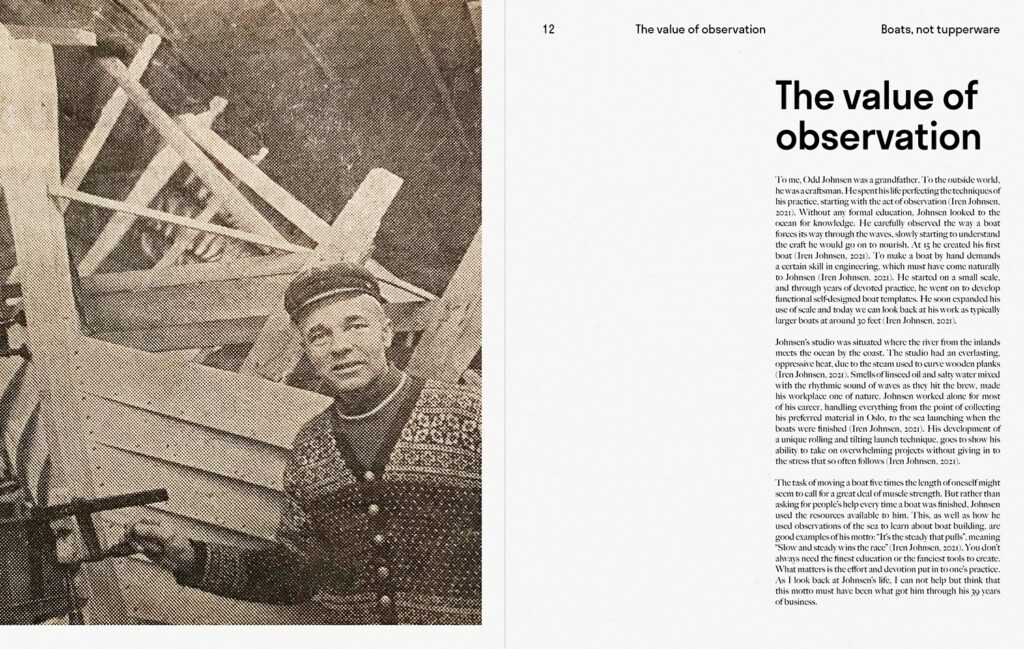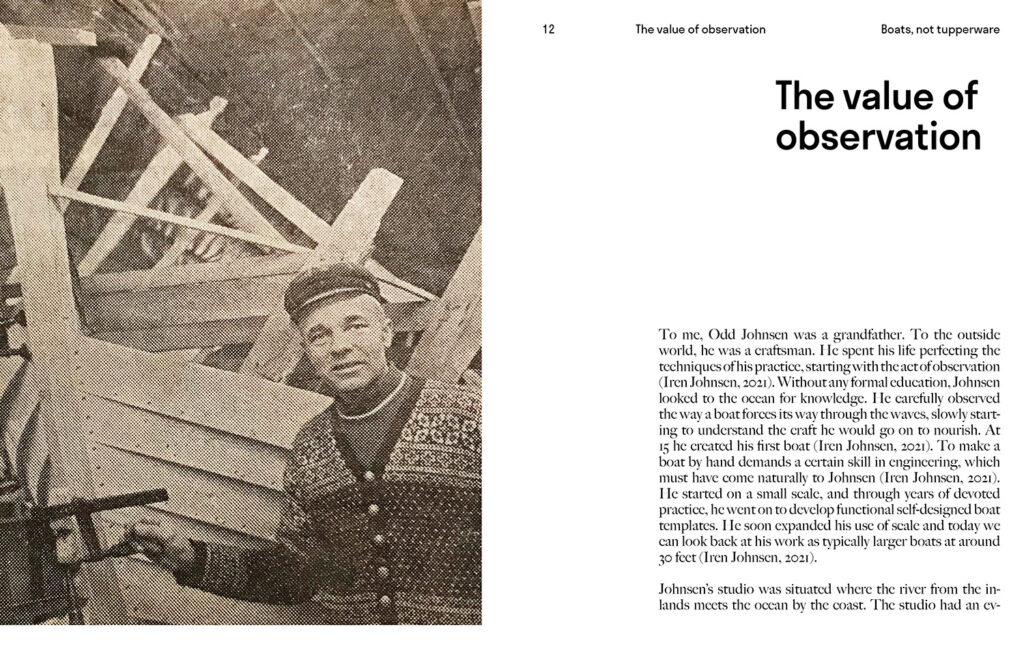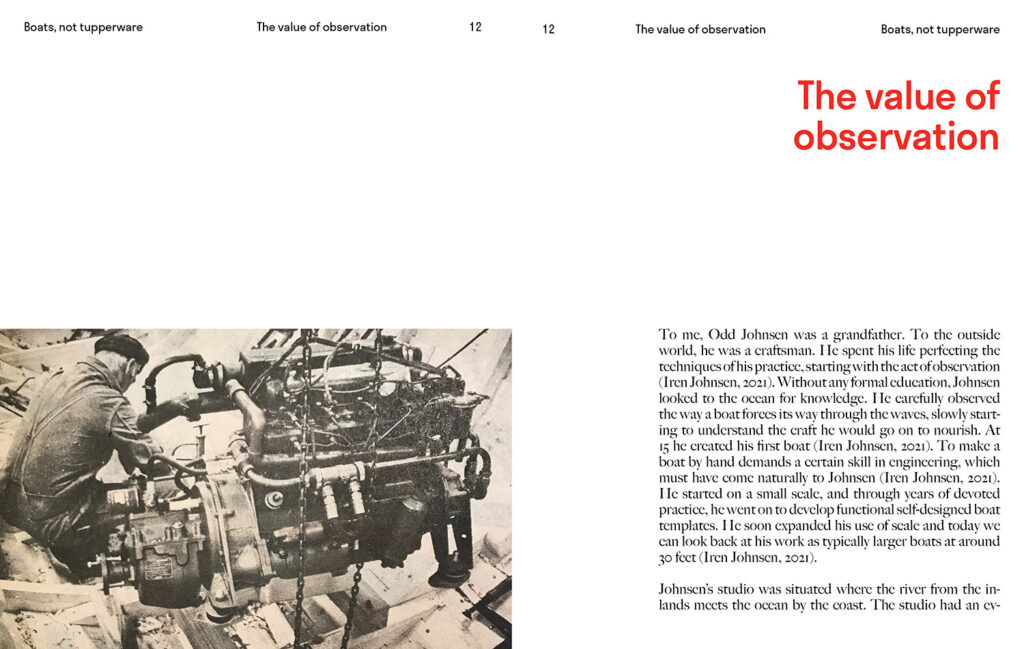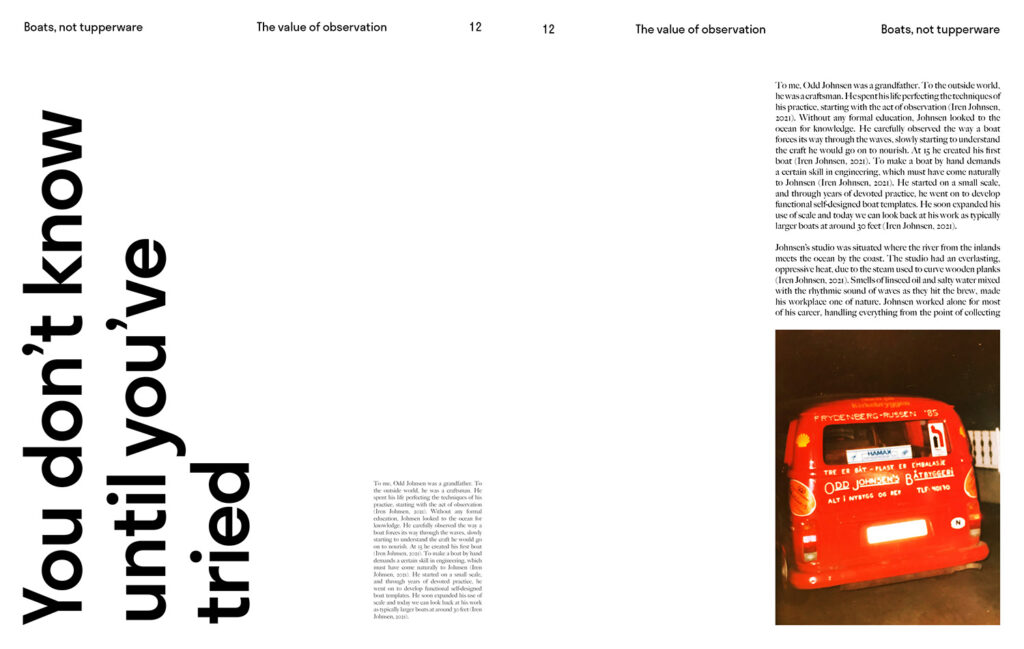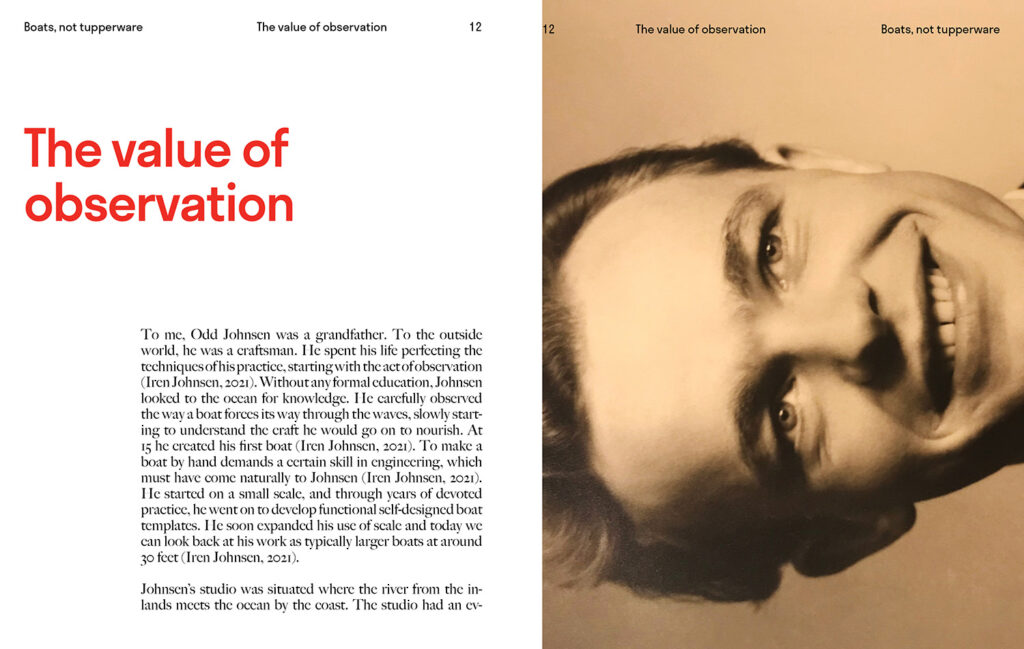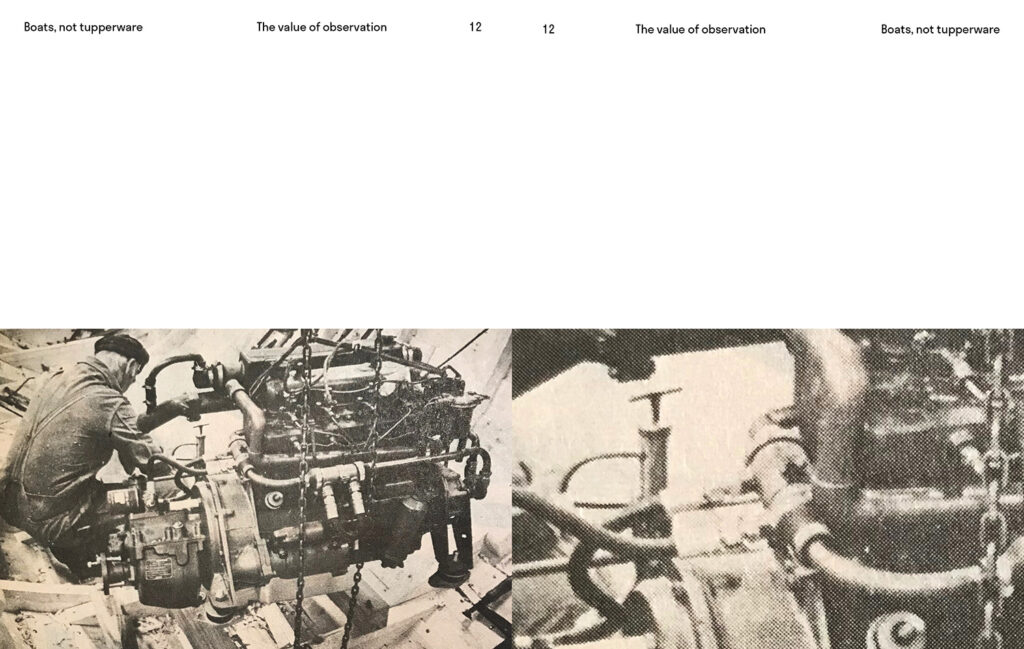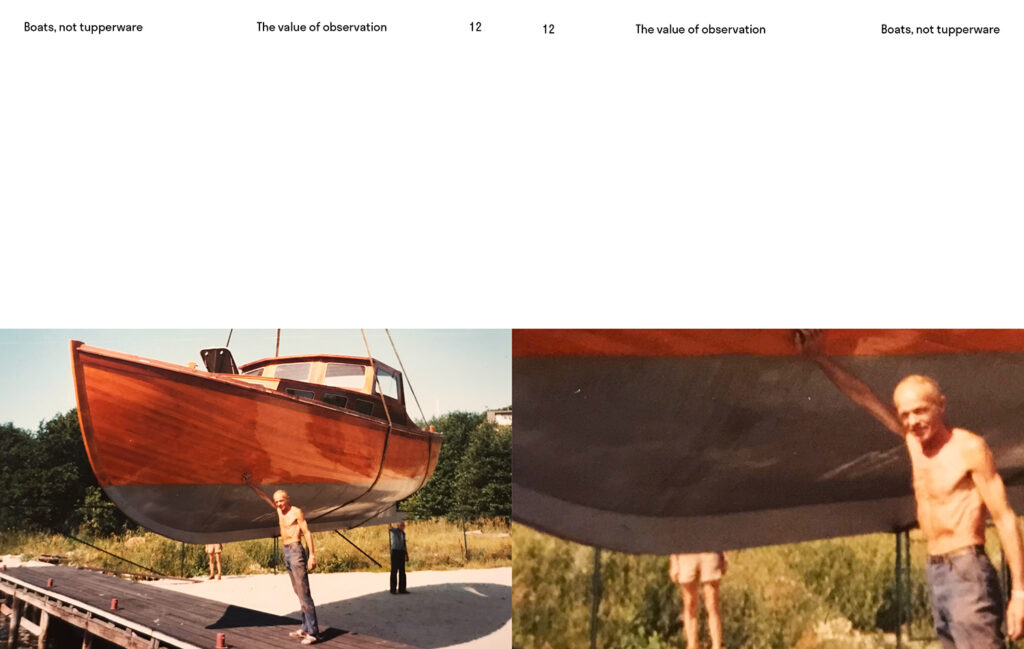Lecture notes
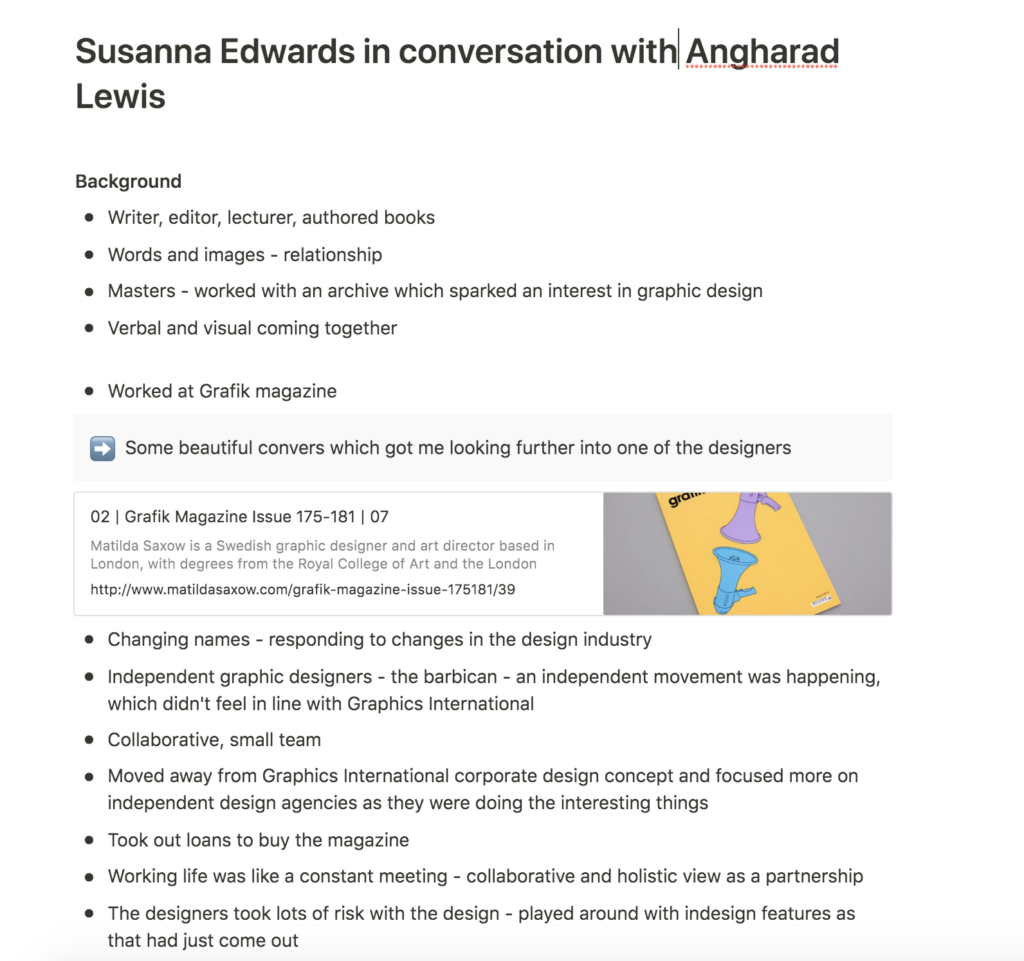
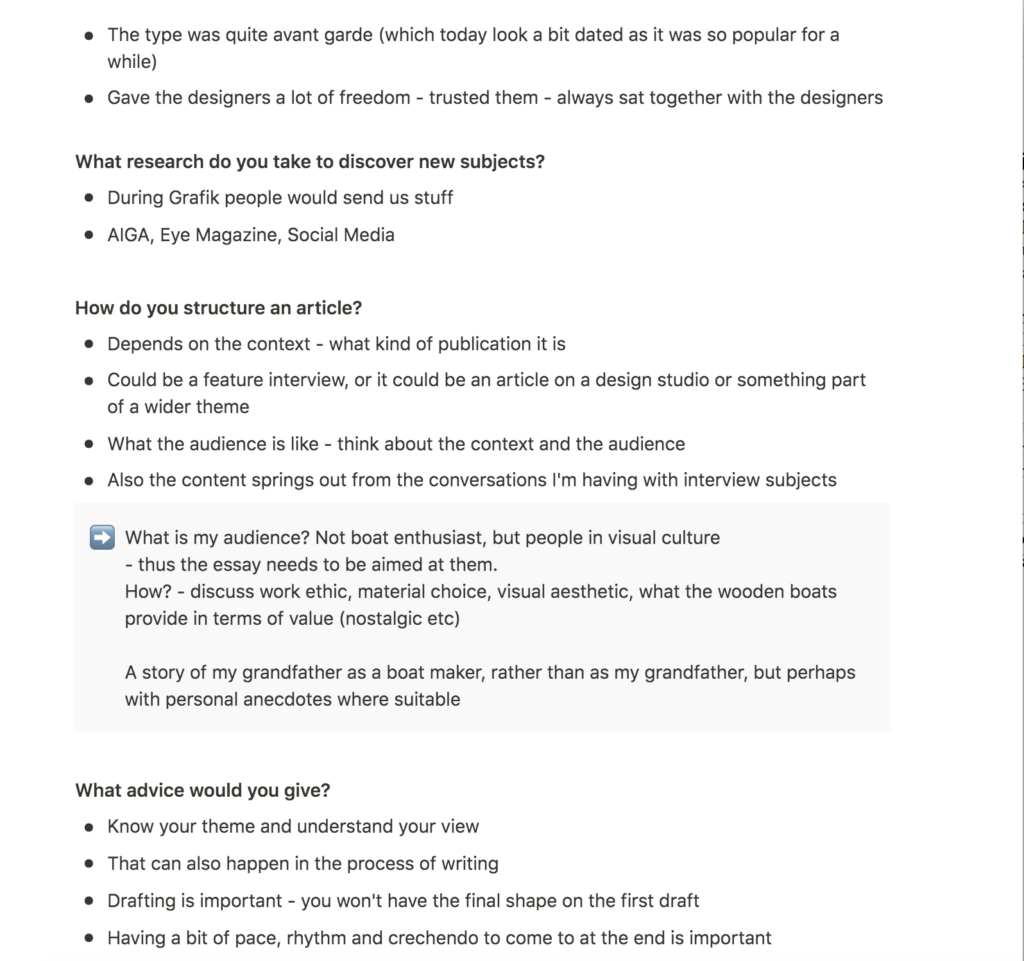


Lecture reflections
I really enjoyed Edwards and Lewis’ conversation on how to structure an article, as it made me reflect on what my audience might be for the essay (Susanna Edwards and Angharad Lewis, 2021). When writing about wooden boats, one might think that the audience should be boat enthusiasts. However, my audience should be those engaged with visual culture, and so my article should perhaps discuss the visual and craftsmanship aspects of boat building, rather than being technically oriented.
Lewis’ comment on the pacing of an article was also an important reminder (Susanna Edwards and Angharad Lewis, 2021). In order for my text to work, it should have a rhythm, but also a climax, and when I am to start writing my draft, I should perhaps reflect upon what this climax could be (Susanna Edwards and Angharad Lewis, 2021).
Turning ordinary into interesting
Further, I enjoyed Lewis’ point of how independent publishing has led to people making interesting publications by focusing on ordinary subjects (Susanna Edwards and Angharad Lewis, 2021). My topic (boat building) is perhaps not a trendy subject, and so I think it’s vital that I manage to do something interesting with it in order for it to become relevant. It should not just say how one can make a boat, but perhaps comment on the unique craftsmanship and how my grandfather’s way of living can be translated into the contemporary creative crafts scene.
Resource notes

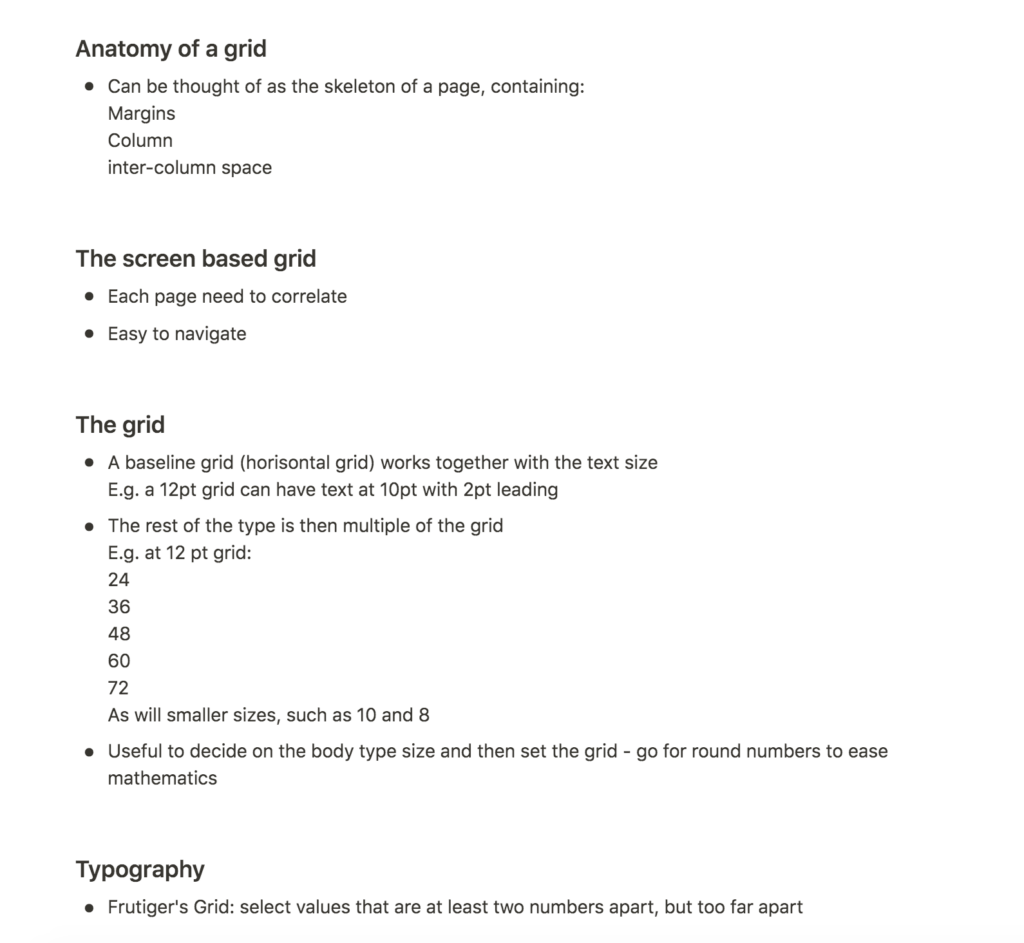
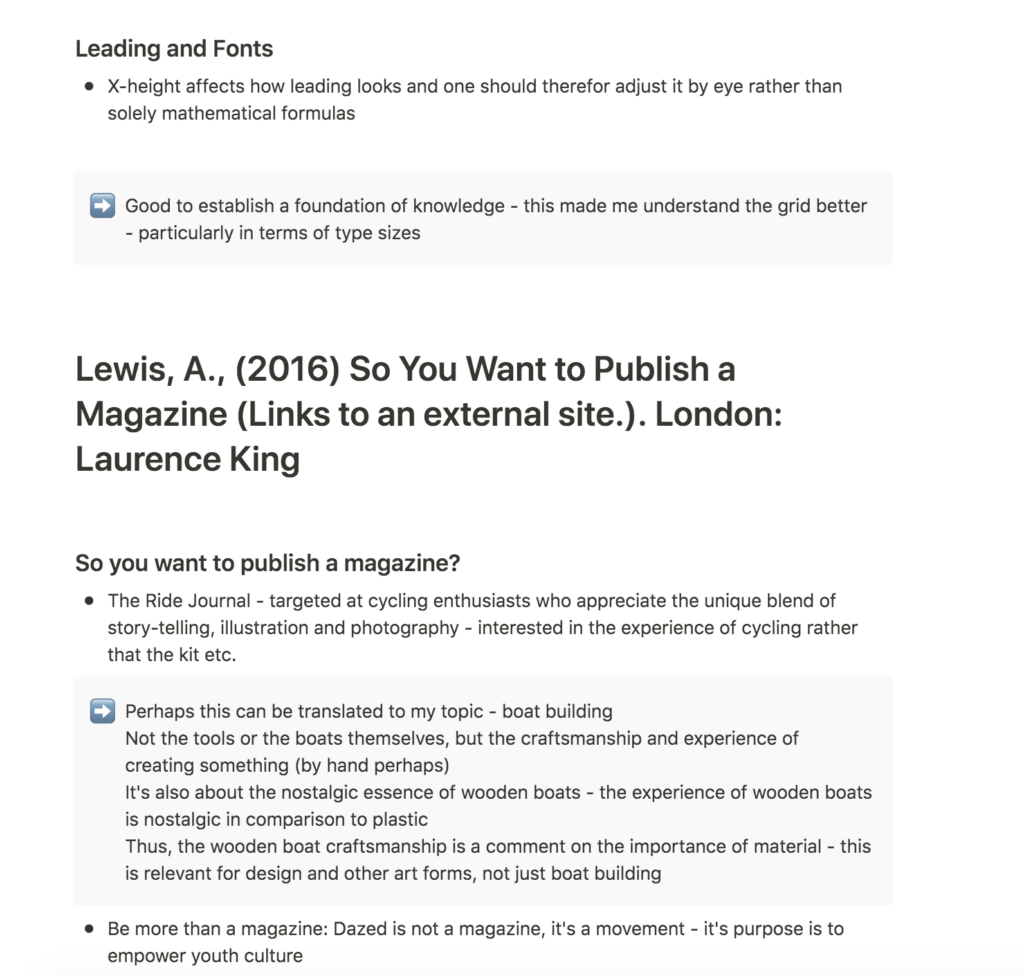
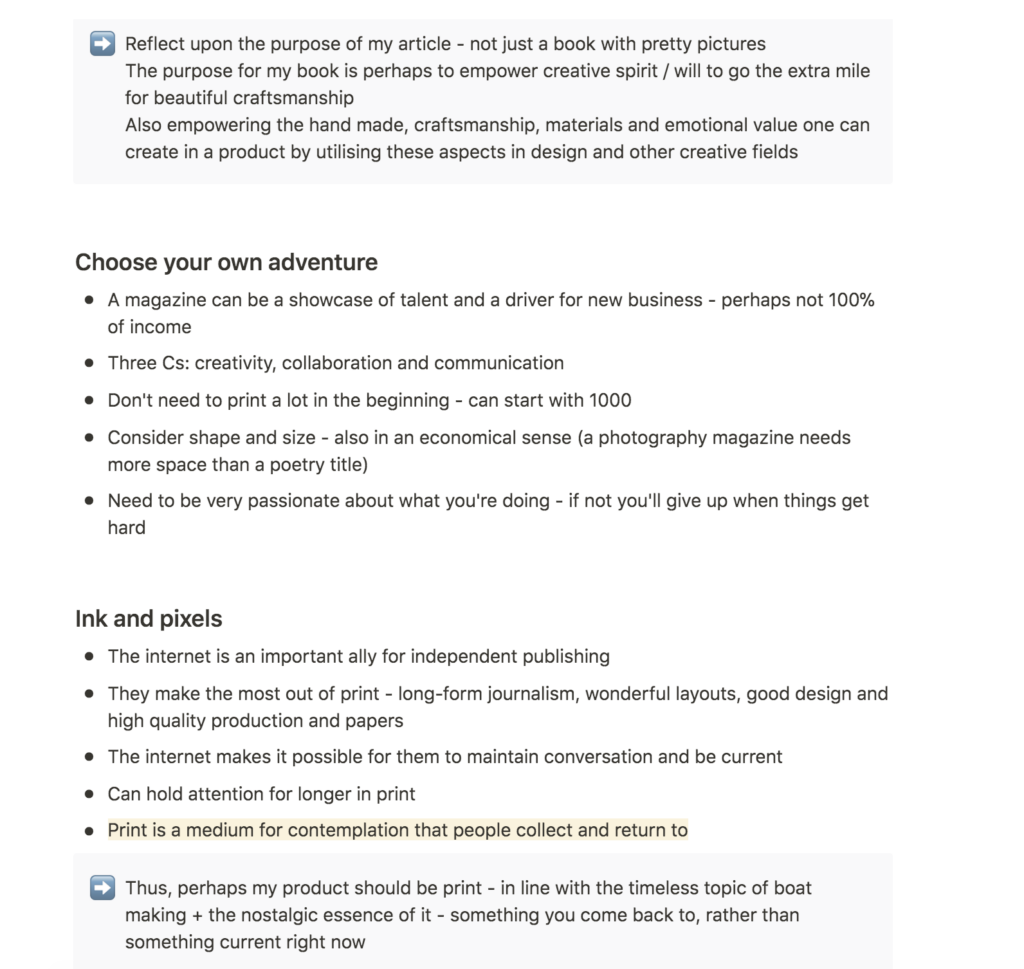
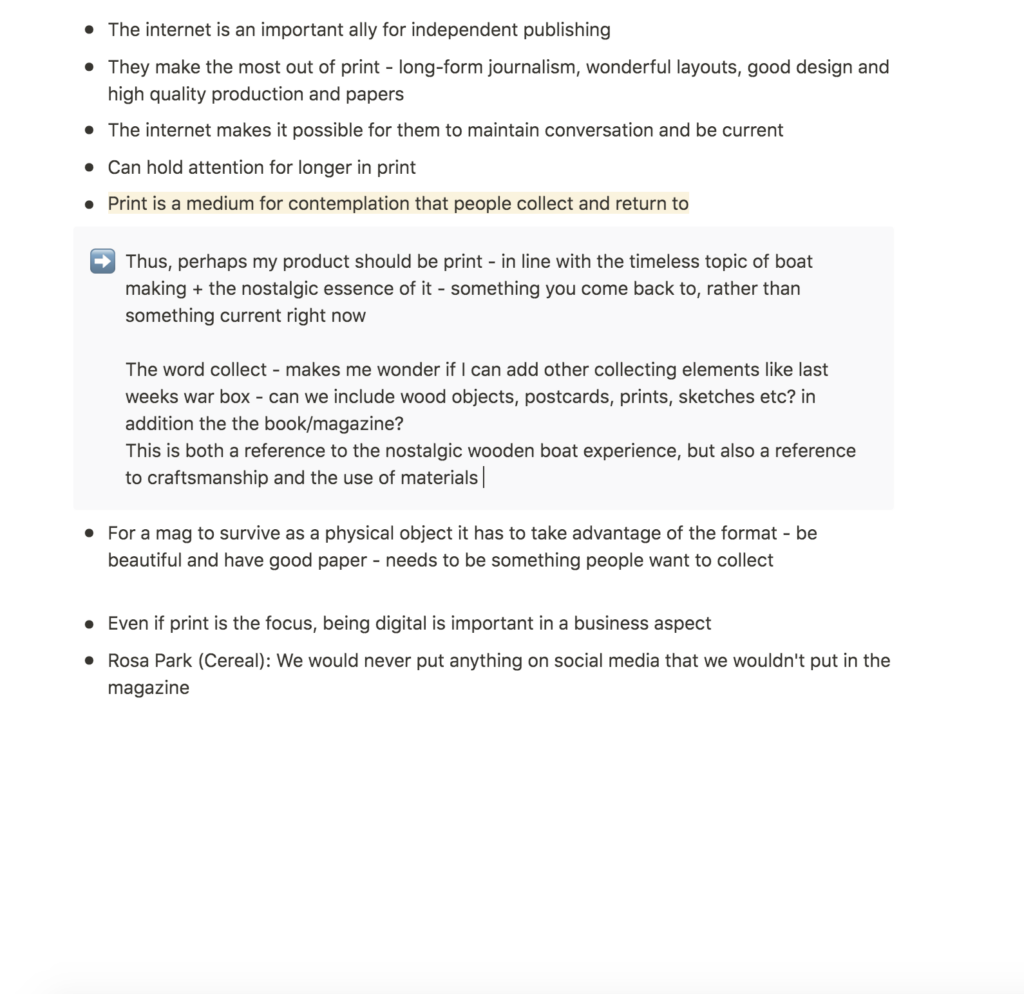
Resource reflection
What is the purpose of my essay?
So You Want to Publish a Magazine was an interesting read which made me reflect further upon the essence of my article. The notes on how The Ride Journal portrays the experience of cycling (Angharad Lewis, 2016), made me wonder if I in a similar way can portray the experience of craftsmanship. In order to target creatives, my article could focus on the act of creating, perhaps by hand.
I was also inspired by Dazed and Confused’s purpose: to empower youth culture (Angharad Lewis, 2016). In order for my publication to become something more than pretty pictures on a page, it should have a purpose. This might be to empower creative spirit and the act of going the extra mile for a piece of beautiful craftsmanship. It might also be to empower the hand made, and how the use of material can awake an emotional value. This might be a way of using the ordinary (and perhaps slightly outdated) topic of boat building as a metaphor for creative work in general.
What do people want to collect?
The discussions on how print should be an object people would want to collect and come back to really stuck with me (Angharad Lewis, 2016). Print suits the timeless essence of my topic, but also the nostalgic value of wooden boats. By creating a publication (or perhaps a box of printed objects, inspired by last week’s research) I could make an object that sits on the shelf, reminding contemporary creatives about the important aspects of craftsmanship (ranging from the choice of material to more general life wisdom, such as taking your time and believing in yourself).
Further research
Lifestyle articles
Inspired by my reflections on taking an ordinary subject and making it interesting, I decided to read a few articles from independent magazines. I discovered Kinfolk article, Sea Change, and Cereal article, Nakashima. Both articles had a tone of voice that felt quite exploratory, yet calm. I also really liked the way each article talked about water and wood, the two materials in focus in my essay.
A slow writing pace to reflect the handmade aspect of boat making
The slow pace of the articles if something I would like to try and incorporate into my own essay. I think this would suit the nostalgic essence of wood boat making, but also the way my aunt described my grandfather’s way of working (he was calm and believed that putting in work evenly lead to getting it done). If I am to focus on handcraft, the slow pace could be complimentary to that as slow and handmade feels like a contrast to digital, which can be very fast paced.
Production methods
As suggested in this week’s workshop challenge video, I decided to have a look at a print production company for inspiration on production methods. Gøteborgtrykkeriet in Sweden creates many beautiful books, and so I had a look at their portfolio.
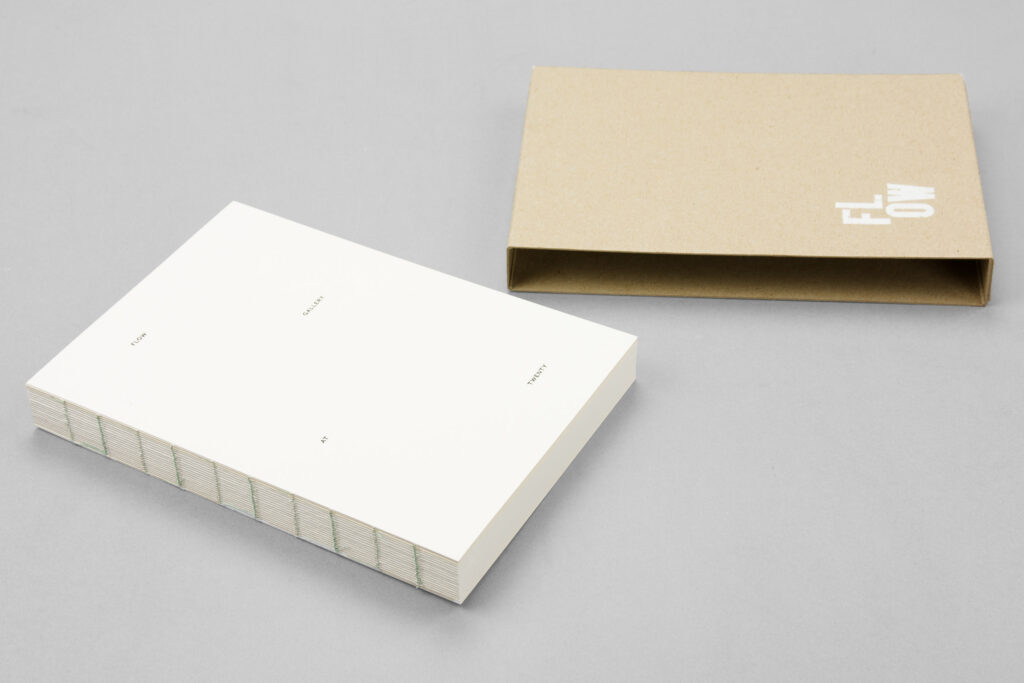
Flow Gallery at Twenty is a beautiful publication which feels very much in line with my concept. As I want to focus on handcraft in my essay, the publication should show traces of that as well. Thus, I think an open spine would be very fitting. I also like the idea of having a box or sleeve, as it could potentially be made out of wood.

The company has also done several beautiful publications for ACNE. They feel innovative and very craftsmanship focused. I think my publication would do well to go follow a similar pathway. The embossing in the box above would look amazing on wood (if physically possible), representing the wood carving my grandfather performed on some of his boats.
Workshop challenge
I’ve chosen to go ahead with the essay concept about my grandfather’s boats, as this was the concept I found most interesting. Based on my previous reflections I decided to focus on his approach to boat building, but also his way of living as he was a calm problem solver who built his business from scratch without education. Through discussing his work, but also wooden boats and the connections between his craft, nature and nostalgia, I hope to create an “inspiring” essay that is relevant for people working in creative fields today.
When writing, I like to get going with drafts as soon as possible, in order to verbalise initial thoughts and ideas. However, before starting, I noted down some key points that I wanted to inform my essay, as well as loose headlines with a list of main points for each chapter. This approach was inspired by the writing workshop from week 4 and I think it was very useful as it gave me something to build upon. Further, I had a quick look at my favourite Norwegian books by author Heidi Furre, as they have a beautiful tone of voice which feels very nostalgic.
After finessing my text a few times, I finished my first draft. Through experimenting with my writing, I came to the conclusion that I wanted my essay to feel slow paced and descriptive of the nature of wooden boats. Referring to the sea, I also wanted it to feel fluid, as if the reader was floating through the text. I did not want it to be a technical text about boat building, but rather a set of personal reflections on my grandfather, working with natural materials, life lessons and craft.
Tutorial with James
After writing my first draft, I still felt as if there was something missing in terms of a creative concept. Luckily I had a tutorial with James which led to great insights and ideas.
We began by discussing songs of the sea, which I thought was a great idea for further writing. We also discussed how the text could potentially be a standard essay (similar to my first draft), accompanied by a simple idea like a more refined version of my intro memory. James also suggested to look at a boats structure to inform the structure of my text, for example by having one poetry line in the middle of the text, to represent the foundations of a boat.
I’ve also noted down some other points of discussions, which I might revisit:
- Mapping the life of my grandfather
- The boat as the afterlife of a tree
- Why do we name our boats and not our cars?
- Text and layout could be airy and light
Rewrite
After my tutorial, I also asked my partner to read through my draft. We came to the conclusion that my text needed restructuring, and clarification on certain points. I went through my text again, by printing, marking and moving bits around, and finally ended up with a second draft. As I was writing I got the idea of making a poem towards the end of my text (see marked area in draft 2). The poem will comment on the sentence “a cycle of natural touch points”, by taking the reader under water where the tone of voice is more lyrical. I will continue to develop this part of my essay next week. In terms of visuals, I got the idea of making the poem section of the essay appear as if under water, by using blue gel pages or perhaps blue coated paper to symbolise water.
Visual process
Based on last week’s research and thoughts that arouse as I was writing, I started my ideation process by sketching.
Box of memories
In regards to my essay, I wanted the design to feel floating and airy. Based on research from one of the previous weeks, I had the idea of making a wooden box (referencing my grandfather’s building material), which would be filled with memories. These memories would consist of a main book/magazine, but also other elements like a poster, notes and images. This idea could perhaps work nicely with the nostalgic comments from my essay.
A tactile experience
As my text discusses craftsmanship and hand made approaches to boat building, I wanted my product to be physical and to offer a tactile experience. The reader should almost be able to feel the texture of the nature I describe in my text. I therefor focused a lot on production methods in my ideation process. In my third sketch above, I’ve tried to explain my initial plan for the book. The main paper should be rough and uncoated, as a reference to wood. The spine should be open to symbolise that the book will discuss craft and the behind the scenes of boat building. As the book reaches the poem (which I will write next week – please see draft 2 for explanation), the paper will turn deep blue and become coated, in reference to water. If possible, I would also like to use a blue gel paper/plastic as a separating element, to symbolise that the reader is about to go under water.
Imagery
I am still not sure about imagery and illustrations, but at the moment I’m leaning towards a combination. I received a bunch of old photographs of my grandfather from my mom, and I think these could add a lot of value to my text by humanising him. The nostalgic look of the images also suits my comments on the nostalgic value of wooden boats from my essay.
As I come from a photography background I think it could be good to supplement with new images of nature (and possibly boats if I can find any close to where I live). If I am to use illustrations, I would like to use a hand made approach, like lino printing, wood block printing, sketching or painting. In last week’s image I created a geometric sketch, and I would like to continue exploring this direction, perhaps by making a realistic line sketch of one of my grandfather’s boats.
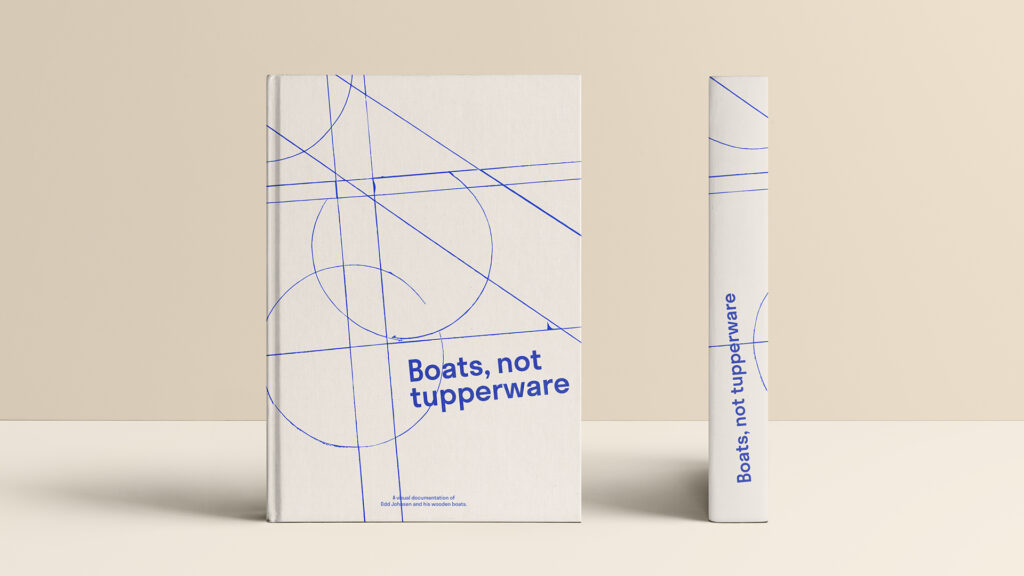
AI animation
During the week, I discovered a new AI-service from MyHeritage, which makes old images of people come to life. I decided to experiment with this briefly as I discuss my grandfather living on through his boats in my text. Thus, being able to see him “alive” through video, perhaps by using QR-codes or other smart phone technology, could be interesting. However, the video does make him look slightly creepy, so I’m not sure if I’ll go ahead with this idea.
Collecting references
After sketching and mapping initial ideas, I went on to collect references for my moodboard. I looked at minimalist magazines for inspiration with airy layout designs. I also researched various production methods that could illustrate my ideas. Further, I went on to experimented briefly with a potential grid- and layout design for the book, using the old photographs of my grandfather. I like the way the images and the airy layout is coming together, but I would like to work further on typography and illustrative pieces.
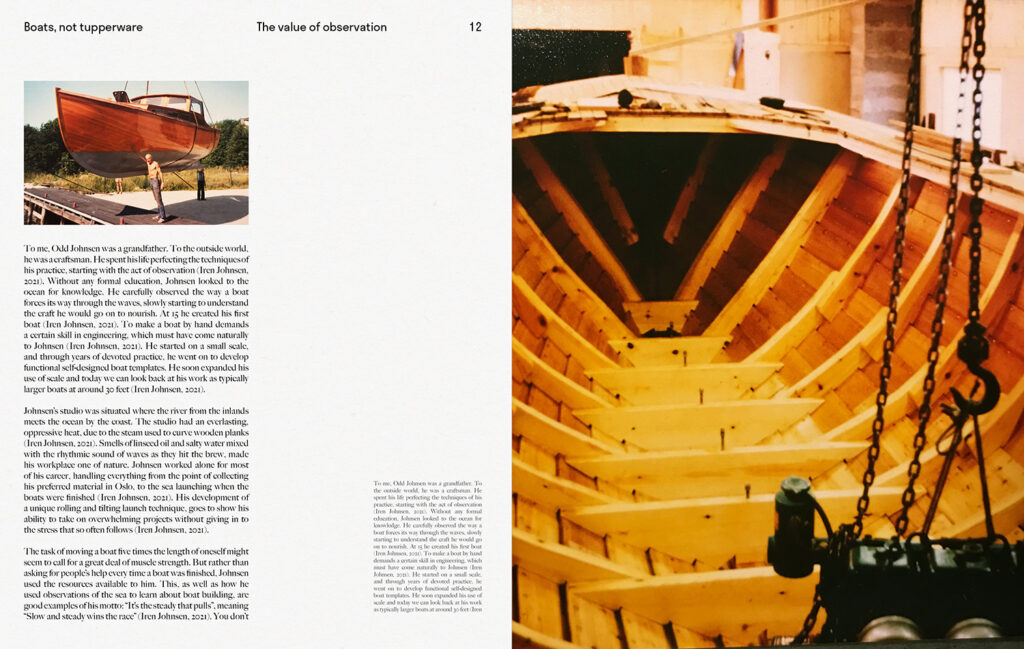
I thought the visual identity should be classic and functional in reference to the timelessness of wooden boats. Thus, I have attempted to find a functional sans serif, as well as a classic and light serif. This feels rather safe at the moment, so I’m hoping to create a more dynamic layout next week. The static look of the layout is in line with functionality, but I still think the floating essence of my essay is missing. Perhaps illustrations could help evoke this.
Below is my final moodboard for the this week’s challenge. The references should be in line with my reflections above, but please also see the image texts for further elaboration.
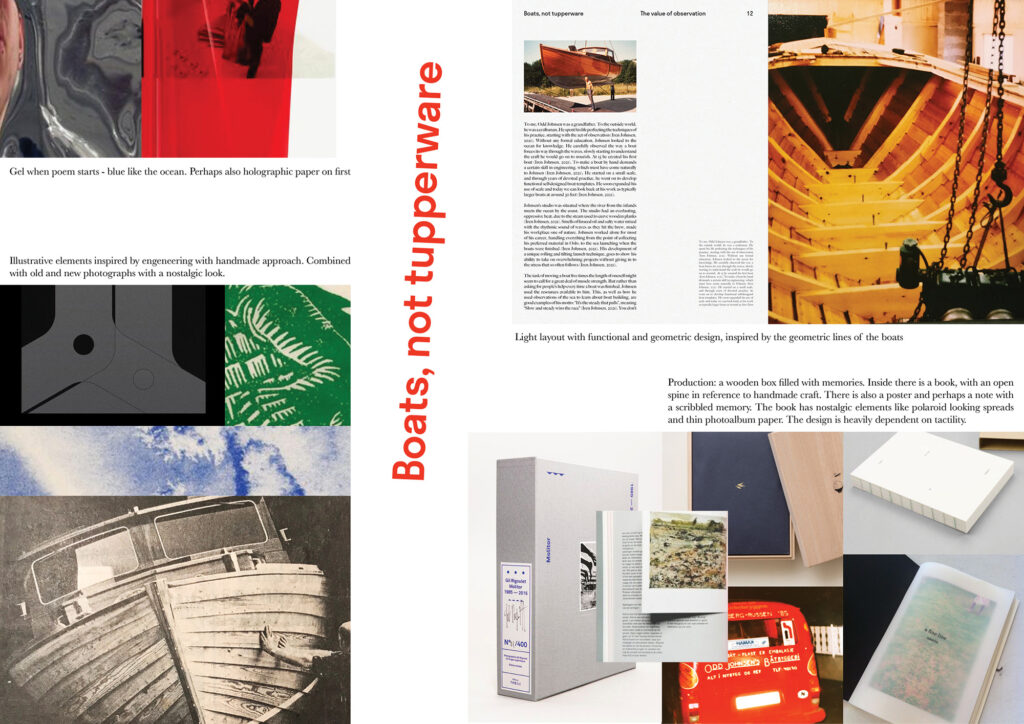
In conclusion
Lewis’s discussions on how independent publishing has led to people doing interesting things with ordinary topics (Susanna Edwards and Angharad Lewis, 2021), was an important starting point this week. It made me question the focus of my subject and reflect upon who the essay would be written for. In order to target those concerned with visual culture, I decided to use boat building almost as a metaphor for those concerned with handmade craft today.
I have found this week slightly challenging as writing, at least in a conceptual way like my current project, is not something I do very often. Yet, it’s been interesting to attempt to write a creative piece. After structuring my second draft, I also found it heading in a direction that I’m happy with. Next week, I’m planning to write the missing chapter, which will be a poem that “takes the reader under water”. I think this will be beneficial as it might help me create something unique, rather than a straight forward text.
Although I think my text has benefited from being a priority this week, I’m currently lacking a clear concept for my moodboard. The idea about a box filled with memories fits the concept and I’m happy with my current ideas for production. However, I will need to work on the visual identity to make the design fit the essay’s floating tone of voice.
If I had more time this week, I would have looked at how fluidity and perhaps an organic element could work as part of my design. In order to make it feel contemporary I also would have liked to accompany the old photographs with newer images and handmade illustrations. The typography could also be more dynamic, and as we go on to next week I hope to experiment further with typefaces and dimensions.
All in all, this week has been interesting as it’s put me out of my comfort zone. I have tackled a project which is quite personal, and it’s been rewarding to look back at my grandfather’s life whilst trying to do his work justice through writing.
REFERENCES:
Angharad Lewis (2016) So You Want to Publish a Magazine? London: Laurence King.
Dr. Wallace J. Nichols (2014) ‘Blue Mind Network’, Wallace J. Nichols. Available at: https://www.wallacejnichols.org/122/bluemind.html (Accessed: 8 March 2021).
George Nakashima Woodworkers (2010) ‘Philosophy’, George Nakashima Woodworkers. Available at: https://nakashimawoodworkers.com/philosophy/ (Accessed: 8 March 2021).
Iren Johnsen (2021) ‘Bestefars båter’.
John-Arne Ø. Gundersen (2020) ‘Mesteren og mahogni’, D2, 24 July, pp. 36–43.
Matthew Johnson (2010) ‘Nakashima’, CEREAL. Available at: https://readcereal.com/nakashima/ (Accessed: 8 March 2021).
Shweta Venkatramani (2018) ‘Why we are so attracted to the Ocean’, Medium, 10 January. Available at: https://medium.com/advensure/why-we-are-so-attracted-to-the-ocean-6d778ad65a41 (Accessed: 2 March 2021).
Susanna Edwards and Angharad Lewis (2021) ‘Susanna Edwards in conversation with Angharad Lewis’. Canvas Falmouth Flexible [online], 5 March.
Tim Bossie (2010) ‘8 Benefits to Owning a Fiberglass Boat for Fishing’, Do it yourself, 1 October. Available at: https://www.doityourself.com/stry/8-benefits-to-owning-a-fiberglass-boat-for-fishing (Accessed: 12 March 2021).
Trond Birkeland (2021) ‘Båtbygger Trond Birkeland’. Wikipedia (2021) ‘Motorsjekte’, Wikipedia [online]. Available at: https://no.wikipedia.org/wiki/Motorsjekte#Snekker_med_krysserhekk (Accessed: 8 March 2021).
LIST OF FIGURES:
Figure 1. PENTAGRAM. 2019. Flow Gallery at Twenty. Goteborgs Tryckeriet [online]. Available at: https://gbgt.se/inspiration/flow-gallery-at-twenty/
Figure 2. ACNE STUDIOS. 2017. Lookbook SS17. Goteborgs Tryckeriet [online]. Available at: https://gbgt.se/inspiration/lookbook-ss17-3/
Figure 3: Ingrid REIGSTAD. 2021. Boats, not tupperware, week 6. Private collection: Ingrid Reigstad.
Figure 4. MYHERITAGE. 2021. AI animated grandfather. MyHeritage [online]. Available at: https://www.myheritage.no/deep-nostalgia
Figure 5-12: Ingrid REIGSTAD. 2021. Layout experiments. Private collection: Ingrid Reigstad.
Figure 13: Ingrid REIGSTAD. 2021. Week 7 moodboard. Private collection: Ingrid Reigstad.
